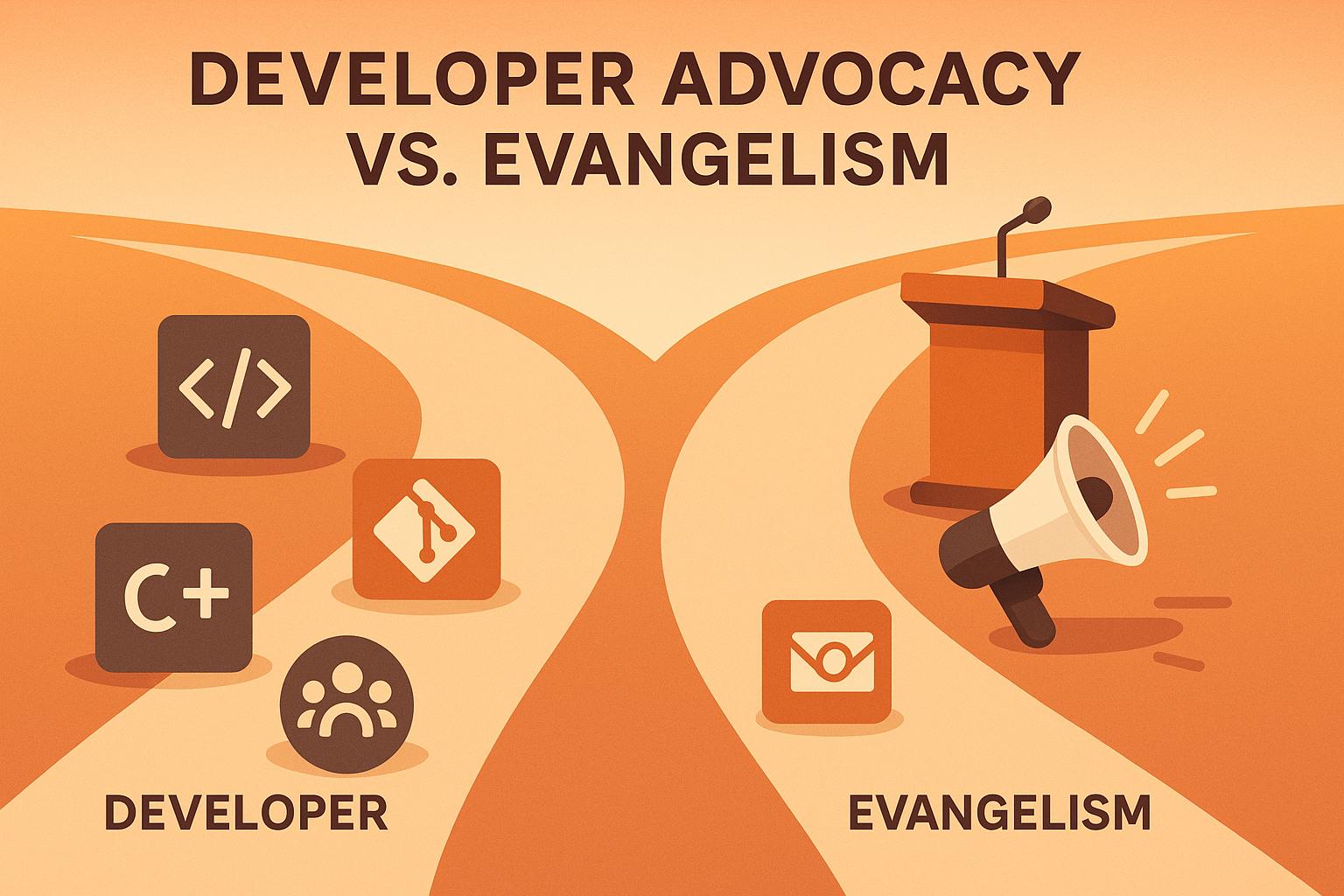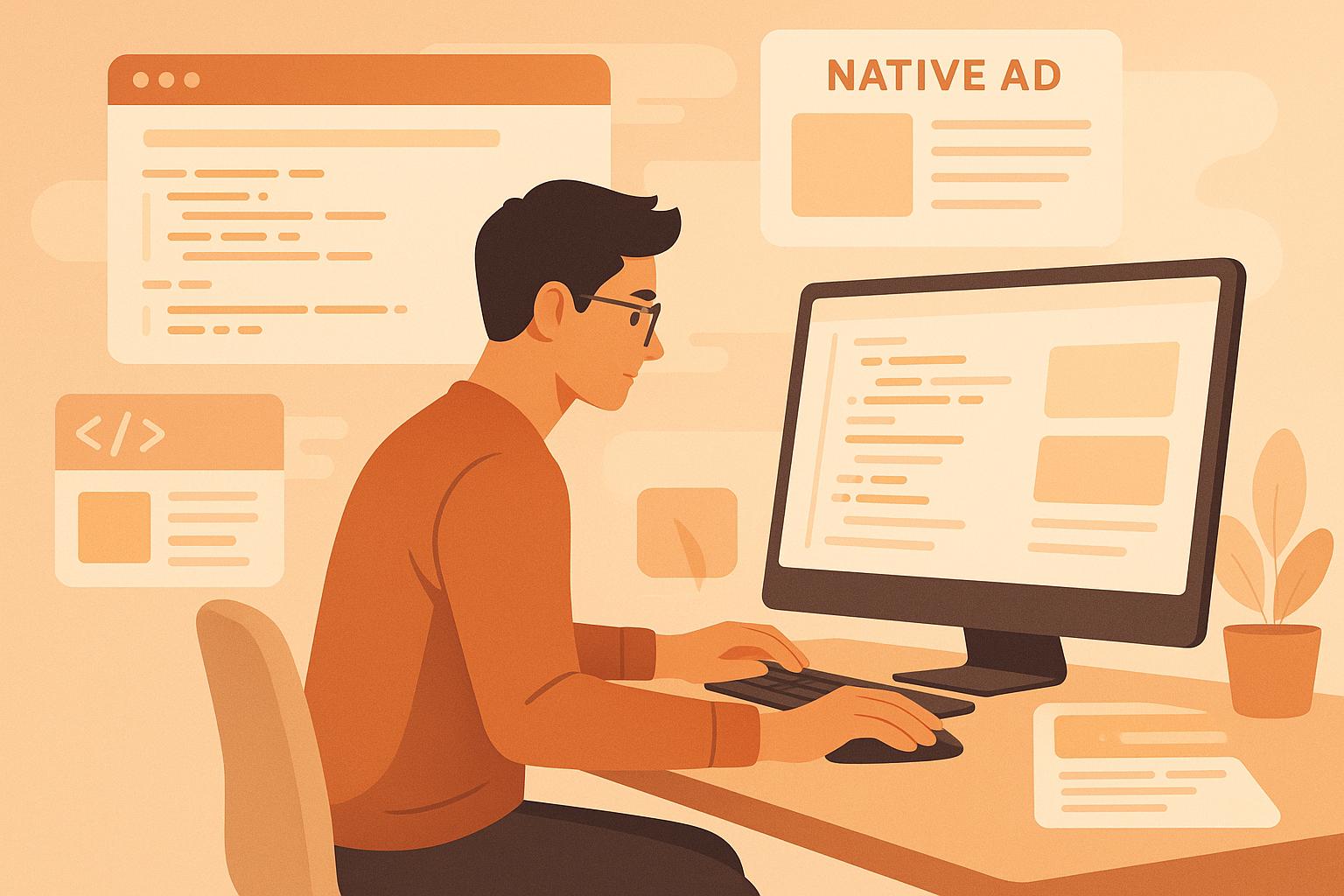


Explore the distinct roles of developer advocacy and evangelism, their goals, communication styles, and how they engage with the developer community.
Developer advocacy and evangelism both aim to connect with developers, but they take very different approaches. Here's a quick breakdown:
- Developer Evangelism: Focuses on promoting a company's tools and technologies. Evangelists are outward-facing, showcasing products at events, creating demos, and driving adoption. Their communication is one-way, aiming to inspire developers to use the product.
- Developer Advocacy: Centers on supporting developers and gathering feedback. Advocates act as a bridge between developers and internal teams, emphasizing two-way communication and improving tools based on developer needs.
Quick Comparison:
| Aspect | Developer Evangelism | Developer Advocacy |
|---|---|---|
| Primary Goal | Promote and drive adoption | Support and gather feedback |
| Communication Style | One-way | Two-way |
| Key Activities | Conferences, demos, presentations | Feedback, forums, tutorials |
| Success Metrics | Adoption rates, sign-ups | Community satisfaction, product improvements |
Understanding these differences helps businesses tailor their strategies to either build awareness or deepen engagement with developers.
Evangelism vs Advocacy with Colin Loretz
Main Role Differences
Let's break down the core objectives and engagement methods of these roles. Understanding these distinctions lays the groundwork for a deeper dive into their day-to-day responsibilities and performance metrics.
Primary Goals of Each Role
As outlined earlier, each role is defined by its unique goals and measurable outcomes.
Developer evangelists concentrate on outward-facing promotion and driving adoption. Their mission is to generate awareness and encourage developers to embrace the product. While they may share developer feedback with internal teams, their primary focus is on creating demand and inspiring developers to "catch up with your vision". Their success is often tied to metrics like conference attendance, product sign-ups, and overall adoption rates.
On the other hand, developer advocates focus on understanding and addressing developers' needs. Their role revolves around listening to the community and ensuring that developers' feedback informs internal product decisions. Acting as a bridge between the developer community and internal teams, advocates aim to make products more aligned with what developers truly need. They are evaluated based on community satisfaction, the quality of feedback they gather, and the product improvements that result from that input.
Side-by-Side Comparison: Advocacy vs. Evangelism
| Aspect | Developer Evangelism | Developer Advocacy |
|---|---|---|
| Primary Focus | Product promotion and adoption | Developer support and feedback |
| Communication Style | One-way | Two-way |
| Main Activities | Conferences, presentations, demos | 1:1 community engagement, feedback |
| Relationship Approach | Persuading developers to adopt technology | Listening to developers and offering help |
| Success Metrics | Awareness, acquisition, adoption rates | Community satisfaction, quality feedback, product improvements |
| Internal Role | Promoting company offerings externally | Representing developers internally |
| Developer Interaction | Broadcast | Direct |
The table highlights a key difference: communication style. Evangelists typically use a broadcast approach, engaging large audiences through conferences, webinars, and public presentations. In contrast, advocates focus on direct, two-way interactions, often connecting with developers through forums, GitHub discussions, or one-on-one conversations. These interactions allow advocates to gather valuable insights and offer tailored support.
For example, Microsoft's Wassim Chegham worked closely with the engineering team, contributing to service design and providing actionable feedback.
Daily Tasks and Activities
This section dives into the daily responsibilities of developer advocates and evangelists, highlighting how their distinct approaches shape their work. While both roles rely on technical expertise and communication skills, the way they engage with their audiences sets them apart.
Developer Advocates: Building Community and Trust
Developer advocates focus on forming genuine connections with individual developers and smaller groups. Their work revolves around fostering two-way communication - listening to the community's needs and responding with practical, tailored solutions. On a typical day, they might write technical documentation, create tutorials to simplify complex topics, or lead interactive workshops. They’re active on platforms like GitHub and community forums, where they provide one-on-one support and gather feedback that helps improve products.
Advocates act as liaisons between developers and engineering teams, sharing insights like API challenges or confusing error messages. This feedback loop helps shape better tools and services. They also produce practical resources such as tutorials, code snippets, and troubleshooting guides that developers can immediately use. This hands-on, supportive approach builds lasting trust and loyalty within the developer community.
Developer Evangelists: Driving Awareness and Adoption
Developer evangelists, on the other hand, focus on spreading the word and driving adoption through large-scale outreach. Their work often involves researching industry events, preparing engaging presentations, and rehearsing for impactful delivery. They create demo videos, write blog posts, and maintain active social media profiles to highlight product benefits and connect with a wider audience. As Jennifer Hooper, Sr. Director of Developer Marketing at Armory, puts it:
"Developer Evangelism is outward facing – it is evangelizing and promoting your offerings to developers."
Public speaking and event participation are at the heart of their efforts. Whether it’s at conferences, webinars, meetups, or live coding sessions, evangelists focus on showcasing technology in a way that resonates with diverse audiences. Christian Heilmann, Principal Technical Evangelist at Mozilla, describes the role as being "first and foremost a translator", someone who can break down complex technologies into accessible ideas that inspire interest and support.
Evangelists aim to create scalable content and experiences that spark curiosity and encourage a broader audience to embrace new technologies.
sbb-itb-e54ba74
Required Skills and Training
The training and skills needed for developer advocates and developer evangelists align closely with their core responsibilities. Both roles demand technical expertise, but their focus diverges: advocates excel in listening, community engagement, and feedback translation, while evangelists hone persuasive communication and product knowledge to encourage adoption.
Interestingly, research shows that 77% of professionals in developer relations possess some technical background, and 86.6% gain their skills primarily through on-the-job experience. This highlights how practical, hands-on learning plays a central role in mastering these positions. Let’s explore how training adapts to the unique demands of each role.
Skills Training for Developer Advocates
Developer advocates need a mix of technical proficiency and interpersonal skills to effectively connect internal engineering teams with the broader developer community. As Wassim Chegham, Senior Developer Advocate at Microsoft, describes:
"Our role is to act as the bridge between internal engineering teams and our developer community. We also advocate for developers internally."
Empathy stands out as a cornerstone skill for advocates. Sam Julien emphasizes its importance:
"Technical skill can be learned quickly on the job, but empathy has got to be there from day one."
This empathy allows advocates to deeply understand and address developers’ challenges. Training for this role often focuses on active listening, collecting feedback, and fostering strong community relationships. These skills ensure that advocates can effectively represent developers’ needs within their organizations.
In contrast, developer evangelists take a different training path, focusing on outreach and storytelling.
Skills Training for Developer Evangelists
Developer evangelists thrive on persuasive communication and marketing techniques. Their training prioritizes strategies for creating excitement around new technologies. Storytelling plays a crucial role, as evangelists learn to craft engaging narratives that inspire developers to explore and adopt new tools.
Product expertise is another key area of focus. Evangelists must demonstrate how a product works in practical scenarios, showcasing its capabilities to developers with varying technical expertise. This requires not only technical understanding but also the ability to explain complex ideas in simple, relatable terms. Training for evangelists emphasizes marketing, adaptability, and clear communication. Patience is equally essential, as evangelists often engage with diverse audiences who may need extra guidance to grasp advanced concepts.
Chuq Von Rospach sums up the multifaceted skill set required in developer relations:
"A good developer advocate is hard to find; they need to be good with technology, good with people, good with management, good with words and a positive person to be around."
This insight highlights the shared need for technical knowledge and interpersonal skills, with advocates channeling these abilities into representation and evangelists using them to drive adoption.
Ultimately, the training for each role reflects its purpose. Advocates focus on listening and representing, while evangelists concentrate on persuasion and promotion. Understanding these differences helps organizations create tailored training programs and set clear expectations for each role’s development.
Using Developer Outreach and Advertising Platforms
To maximize the unique strengths of each role in developer relations, leveraging specialized outreach platforms plays a crucial part. Both developer advocates and evangelists use these platforms to connect with their audiences, but their approaches differ. Advocates focus on genuine community engagement and gathering feedback, while evangelists aim to build broad awareness and promote products.
Jennifer Hooper explains that evangelists concentrate on promotion and outreach. They use advertising platforms to extend their reach at conferences, boost webinar attendance, and direct traffic to product demos. These platforms are particularly effective for large-scale awareness campaigns, helping evangelists highlight product benefits to diverse developer communities.
Developer advocates, however, take a more relationship-driven approach. They use these platforms to encourage two-way communication, collect feedback, and share resources that address developers' real needs. Instead of pushing direct product promotions, advocates often rely on targeted ads to promote community events, educational materials, and support tools.
The content strategies also reflect these differences. Evangelists create broad thought leadership content to generate excitement, while advocates focus on practical tutorials and guides that respond to specific community feedback.
As Randall Degges, Head of Developer Advocacy at Okta, puts it:
"Developers are a very difficult audience to crack, and you have to approach them in a very different way. You have to get really creative and provide useful information and tools".
These distinct strategies underscore the importance of platforms like daily.dev Ads, which cater effectively to both advocacy and evangelism.
How daily.dev Ads Supports Both Advocacy and Evangelism

In today’s developer relations landscape, daily.dev Ads provides tools tailored to the needs of both advocates and evangelists. With access to over 1 million developers worldwide, the platform offers precise targeting options based on seniority, programming languages, and specific tools. This flexibility allows each role to focus on their unique goals.
For evangelists, daily.dev Ads delivers broad reach for awareness campaigns. Features like in-feed ads and post page placements help promote product launches, conferences, or thought leadership content - all while maintaining the authentic tone developers expect.
For advocates, the platform emphasizes community engagement. Its trusted environment enables campaigns that promote events, share educational resources, or gather feedback. Personalized digest ads ensure that content aligns with developers' interests and challenges, fostering deeper connections.
The platform also offers real-time performance tracking, which benefits both roles. Evangelists can measure awareness metrics and conversion rates, while advocates can assess engagement levels and community involvement. This data-driven approach helps refine strategies and improve outcomes.
With 35% of DevRel teams reporting to marketing departments and nearly 25% to engineering, daily.dev Ads bridges the gap between these perspectives. It provides user-friendly campaign management tools for marketers while maintaining the technical credibility that advocates require.
Importantly, the platform’s developer-first approach ensures campaigns feel natural and non-intrusive. As Christian Heilmann, Principal Technical Evangelist at Mozilla, explains:
"A developer evangelist is first and foremost a translator. Someone who can explain technology to different audiences to get their support for a certain product or technology. It needs to be someone who is technical but also capable to find the story in a technical message…A good developer evangelist can get techies excited about a product by pointing out the benefits for developers who use the product on an eye-to-eye level."
Both advocates and evangelists benefit from daily.dev Ads' expert creative support, helping them craft campaigns that resonate authentically with the developer community.
Choosing the Right Approach for Your Organization
When deciding between developer advocacy and evangelism, it’s not just about job titles - it’s about aligning your business strategy with the best approach to engage developers. The right choice hinges on factors like your market position, the maturity of your developer community, and your long-term objectives.
If your priority is rapid awareness and adoption, developer evangelism could be the way to go. This approach is particularly effective for launching new products, entering competitive markets, or introducing developers to emerging technologies. Evangelists are skilled at generating excitement and sparking interest in your solutions.
On the flip side, if your focus is on sustainable growth and building trust within the developer community, developer advocacy might be a better fit. Advocacy shines when you need ongoing feedback, want to lower support costs, and aim to cultivate a thriving, self-sustaining ecosystem. For example, MuleSoft’s Champions Program, with 6,000 engaged advocates, has produced over 2,000 blog posts, hundreds of tutorials, 300+ videos, and even full-length books - all at a fraction of the cost of employing a single developer evangelist. These differences highlight how each approach aligns with distinct budget and trust dynamics.
Budget and Trust Considerations
Budget and trust play a significant role in determining the best approach. For instance, one company’s full-time evangelists created nearly 300 blog posts, 15 tutorials, and about 20 videos at a cost of $1,000,000. In contrast, community-driven advocacy programs often generate more content and foster deeper trust at a lower cost. As Gail Goodman, Founder and Former CEO of Constant Contact, aptly put it:
"We trust complete strangers more than we do companies..."
This insight underscores the power of community engagement in building credibility and achieving long-term goals.
Matching Roles with Business Goals
Choosing the right approach starts with an honest evaluation of your organization’s needs and the current state of your developer relationships. Ask yourself: Is your primary challenge creating awareness, or is it fostering deep engagement?
- Go with evangelism if your goal is to drive immediate adoption, educate the market on new technologies, or compete for attention in a crowded space. Evangelism is ideal for established companies seeking broader market penetration or startups aiming for rapid user acquisition.
- Lean toward advocacy if you’re focused on building lasting community relationships, gathering product feedback, or creating a sustainable support network. This approach works well for companies with complex developer tools or those looking to enhance the developer experience while reducing support costs.
Internal structure also matters. Developer advocates often serve as a bridge between engineering teams and the community, ensuring that feedback is not only heard but acted upon.
Considering a Hybrid Approach
Sometimes, a hybrid strategy can be the best solution. For example, you might start with evangelism to build initial awareness and then shift to advocacy as your community matures. The key is to align your metrics with your strategy - track awareness and adoption for evangelism, and focus on engagement and usability for advocacy.
Community building, in particular, has a compounding effect. An engaged community often evolves into a network of advocates, amplifying your message and delivering long-term benefits that go beyond one-way promotional efforts.
Ultimately, the most successful organizations recognize the value of both roles. The emphasis should evolve based on your business phase and the goals you’re working to achieve with your developer community.
FAQs
How can a company choose between developer advocacy and evangelism for their strategy?
Choosing between developer advocacy and evangelism comes down to your company’s goals and what you aim to achieve.
If your priority is creating lasting connections with developers, nurturing a sense of community, and offering consistent support, then developer advocacy is the way to go. This path focuses on engaging developers through education, helpful resources, and collaboration.
However, if your main goal is to quickly increase visibility, spark enthusiasm, and reach a wide audience, evangelism might be a better fit. Evangelists serve as enthusiastic ambassadors, sharing your product or brand’s story to generate interest and expand your reach.
To decide, think about whether your strategy leans more toward building a supportive community or driving broad awareness and excitement.
What are the key skills needed for a career in developer advocacy compared to developer evangelism?
For a career in developer advocacy, you'll need a strong technical background, the ability to connect with developer communities, and top-notch communication and listening skills to gather feedback and share it effectively. This role is all about building trust and serving as a link between developers and product teams.
On the other hand, developer evangelism focuses more on inspiring and educating developers about a specific product or technology. To excel here, you'll need outstanding public speaking abilities, compelling storytelling skills, and a genuine enthusiasm for the product or platform. While both roles blend technical expertise, communication skills, and community engagement, their objectives and methods have distinct differences.
Can a company successfully manage both developer advocacy and evangelism, and how can these roles work together effectively?
Yes, a company can effectively balance developer advocacy and evangelism by clearly defining the distinct roles each plays. Developer advocacy is all about connecting with the developer community - understanding their challenges, offering solutions, and providing support. On the other hand, evangelism focuses on creating enthusiasm and spreading the word about the company’s products or services.
To make these roles work in harmony, fostering collaboration and open communication between the teams is key. Clearly outline shared goals that align with the company’s broader mission while specifying how each team contributes. This clarity not only prevents overlap but also ensures both efforts complement each other, helping the company build a stronger developer ecosystem and achieve its objectives.






